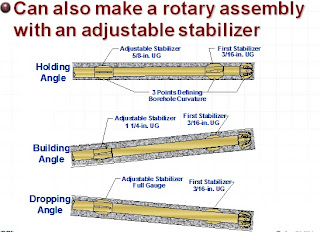Rheology is the study of
how matter deforms and flows
VISCOSITY
Resistance to flow of a fluid
FUNNEL VISCOSITY
- 100 centipoise (cp) = 1 poise
- Centipoise is the dimension used to express:
- Plastic viscosity
- Apparent viscosity
- Effective viscosity
- The dimensions of lb/100 sq ft are used for expressing:
- -Yield point
- - Initial gel
- - 10-minute gel
SHEAR STRESS
- Internal force that resists flow
- System pressure loss (circulating pressure on the rig)
- Simulated by the dial reading on a V G meter
SHEAR RATE
The velocity at which one layer of fluid moves past another
- The bulk (average) velocity at which a fluid is moving
- Annular velocity in the circulating system is an example of bulk velocity
- Velocity is the RPM on a V G meter
Factors Influenced by Mud Rheology
- Hole cleaning
- Suspension of solids
- Hole stability
- Solids control
- Equivalent circulating densities
- Surge / swab pressures
Measurement - Rotational Viscometer
Effect of Temperature & Pressure
- Temperature reduces viscosity
- Pressure increases viscosity
- High temperature
- Breakdown of polymers
- Gelation of solidsPlastic Viscosity
- Resistance to flow due to mechanical frictio
- Affected by:
- Solids concentration
- Size and shape of the solids
- Viscosity of the fluid phase
Hydratable Drill Solids
Clays, shales
Inert Drill Solids
Sand, limestone, etc.
Colloidal Matter
Starch, CMCParticles breaking, thus increasing surface area and more frictionWeight material to increase densityArea Increase by Breaking of Solids
Effect of Particle Size on Viscosity
Plastic Viscosity Decreased byRemoval of Solids
Shale shaker
Desanders, desilters, and centrifuges
Lowering of gel strength allows larger particles to settle out
Dilution of solids with waterHow Solids Affect Mud Viscosityoil spill gulf gulf gulf oil mexico oil spill mexico gulf of mexico oil spill bp bp bp oil oil spill 2010 bp gulf gulf of mexico gulf oil mexico obama oil spill oil spill 2010 oil spill bp oil spill florida oil spill gulf
US sues BP, 8 other companies in Gulf oil spill Gulf oil spill recovery exec dead in plane crash Ex-CEO says BP was unprepared for oil spill BP's oil spill costs grow Scientists to see if oil spill hurt deep sea life Depression soars among Gulf residents after oil spill BP spent $93M on advertising after Gulf oil spill





























































